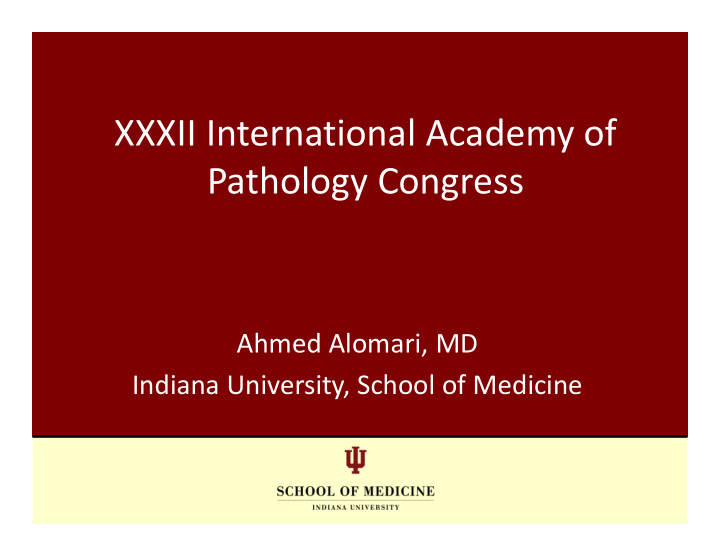



XXXII International Academy of Pathology Congress Ahmed Alomari, MD Indiana University, School of Medicine
Disclosures • No relevant financial disclosures
SL‐06 Inflammatory Dermatosis Case 005
Clinical Presentation • 64‐year‐old gentleman with one‐month history of diffuse pruritic eruption involving trunk and extremities. • No associated constitutional symptoms • Medications: Metoprolol (HTN), Ibuprofen (PRN headache), a daily multivitamin and fish oil
Clinical Presentation • Initial physical examination: well‐demarcated hyperpigmented and violaceous papules coalescing into larger plaques with some areas of sparing. • Initial workup was negative for neoplasia, infections and vitamin deficiencies
Initial Laboratory Results • HIV/HBV/HCV/RPR ‐ neg • ANA ‐ neg • CBC/CMP/Lipid/TSH ‐ wnl • Vitamin B1/B3/B6/B12 and zinc ‐ wnl
Initial Pathology • Initial biopsy was read at an affiliated institution and showed mild interface damage with a predominantly perivascular infiltrate and few eosinophils. • Working diagnosis: lichenoid drug eruption
Initial Follow up • Despite intramuscular steroid injections, the rash progressed with bullae formation predominantly on extremities. • Additional biopsies with direct immunofluorescence were submitted for examination.
IgG
C3
Fibrinogen
Final Diagnosis • Lichen Planus Pemphigoides
Additional Laboratory Data • BP180 ‐ positive • BP 230 ‐ neg
Lichen Planus Pemphigoides • Very rare disorder • Combination of lichen planus lesions and tense bullous eruptions on skin both in involved and in not involved areas of the lichenoid eruption. • Postulated to be a blistering autoimmune response to hemidesmosomal derived antigens exposed after lichenoid inflammation
Causes • Drug reaction – ACE inhibitors, statins, cinnarizine, Chinese herbs and weight reduction products • Complication of PUVA • Associated with Castleman’s disease • Related to internal malignancies
Diagnosis • DIF with fibrinogen deposition at the dermal‐ epidermal junction with cytoid bodies and linear IgG and C3 along the basement membrane zone • Positive BP180 and/or BP230
Treatment • Limited disease ‐ topical steroids • Initial treatment for extensive disease – oral steroids or cyclosporine • Steroid sparing agents including tetracyclines, niacinamide, isotretinoin, Dapsone, CellCept • High rate of remission after initial disease control and patients can generally be weaned off all treatments
Our Patient
SL‐06 Inflammatory Dermatosis Case 006
Clinical Presentation • A 44‐year‐old lady with a PMH of moderate to severe hidradenitis suppurativa, relatively well controlled on adalimumab for the last 3 months presented with a new rash for the past 1‐2 weeks.
Clinical Presentation • Red spots primarily on her legs, with few on her upper extremities • They were not itchy, painful or otherwise symptomatic • She denied any new medications (other than Adalimumab). No recent illnesses or immunizations and review of systems was unremarkable.
Clinical Presentation • Palpable purpuric to erythematous slightly keratotic papules scattered on the bilateral anterior and medial lower legs primarily. • Additionally, she has scarred sinus tracts in the bilateral axillae, inframammary and inguinal folds
Labs • Overall unremarkable • WBC 9.3 – Mild lymphocytosis (3.6) • Punch biopsy of the right medial lower leg – Specimens were submitted for both H&E and DIF given the question of palpable purpura
Adalimumab‐induced Pityriasis Lichenoides Chronica (PLC) • Reported with all TNF‐ inhibitors • Time course is highly variable – Onset of the eruption few weeks to a few months with the maximum latent period being 12 months
Adalimumab‐induced Pityriasis Lichenoides Chronica (PLC) • Mechanism unclear – Close temporal association with drug exposure – Role of drug as an antigenic trigger – Inherent drug immune dysregulating properties
Adalimumab‐induced Pityriasis Lichenoides Chronica (PLC) • Etiology most likely form of T‐cell dyscrasia – Reversible dependent on drug withdrawal – Adding to the spectrum of lymphomatoid drug reactions – T cell subset CD4+ > CD8+ – In two cases, T‐cell receptor gene rearrangement was negative
Treatment • Started on low dose methotrexate (7.5 mg weekly) – Improvement within 6 weeks – New lesions continued to develop over 6 months • Patient elected to switch to infliximab for her hidradenitis with complete resolution
Questions
Recommend
More recommend